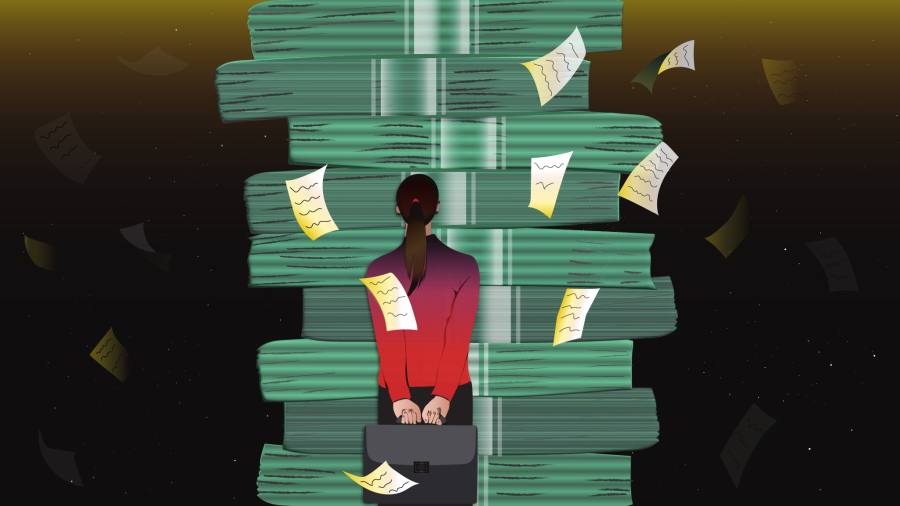[ad_1]
This week, yet more eye-popping economic data has emerged. Take inflation. On Wednesday, it emerged that US annual inflation hit 9.1 per cent in June, the highest level since 1981.
Unsurprisingly, that has raised expectations of increasingly sharp future rises in interest rates. This, in turn, is prompting bodies such as the IMF to slash growth projections, in the US and elsewhere.
But while investors and economists worry about recession, there is another related question to ponder: how will high inflation and rising rates affect the world’s growing mountain of debt?
During most of the past ten years, this debt question has often been ignored by pundits, because a multi-decade decline in rates and inflation kept borrowers’ servicing costs low, or falling. But Wednesday’s number underscores that the climate has changed. Debt data is just as eye-popping as inflation.
A recent report from JPMorgan, which crunches statistics from The Institute of International Finance, starkly details the issue. It notes that total global debt was 352 per cent of gross domestic product in the first quarter of this year, with private sector debt accounting for two-thirds of this, and public sector debt one-third.
The good news is that this ratio has declined slightly from a peak of 366 per cent in early 2021, due to strong global growth. The bad news, however, is that the current ratio is still 28 percentage points above 2019 levels, before Covid-19 lockdowns sparked frenetic government and private sector borrowing.
Moreover, the pandemic-era increase was broad-based and came after a large jump in debt during the 2008 global financial crisis — and the former was considerably bigger than the latter. Thus, total global debt today, relative to GDP, is more than double its 2006 level — and triple the 2000 ratio (when it was under 100 per cent).
Yes, you read that right: leverage in the global economic system has risen more than three-fold this century; and the only reason that this went (mostly) unnoticed was sinking interest rates.
So what happens now if rates increase? No one knows. If you want to be optimistic, you might argue that there is no need to panic since spiralling debt is a feature of an increasingly sophisticated globally integrated world, not a bug. Just as 21st-century consumers often use credit cards instead of cash for shopping, which makes consumer debt seem bigger than before even if retail spending is unchanged, corporate activity today is powered by evermore complex credit flows.
Inside headline gross debt numbers there are also credit flows that sometimes cancel each other out, and the rising value of liabilities is sometimes matched by rising asset values. Thus, while Japan has the world’s highest debt-to-GDP ratio, different government agencies owe debt to each other.
And while China’s private sector debt is almost three times GDP, the deep-pocketed government is implicitly backing some loans. Similarly, while the US also has debt three times the size of GDP, this borrowing is partly offset by the rising values of private and publicly held assets.
“The total increase in gross debt might overstate the rise in debt vulnerabilities,” a recent report from the Committee on the Global Financial System notes. It adds that any “analysis of distributions [of vulnerabilities] requires micro data, which are often not available from public sources”. The nature of creditors, value of offsetting assets and maturity of the debt matters.
Nevertheless, even with these caveats, the trend is clearly worrying the CGFS — so much so that its report uses central banks’ internal data to try to model some of the private sector “vulnerabilities”. This produces a smorgasbord of striking micro data. To cite one example: while 50 per cent of the pandemic-era debt assumed by companies in Italy and Spain is coming due in the next couple of years (making them vulnerable to rising rates), in Germany and America the ratio is just 25 per cent.
Or, to cite another: the CGFS calculates that 17 per cent of companies in industrialised economies are “zombies”, or entities that can only be kept alive by virtue of low rates; in 2006 this ratio was 10 per cent. A third nugget: some 90 per cent of German households expect house prices to keep rising, up from 40 per cent in early 2020 — a pattern that may “amplify the current upswing in household credit”, the CGFS says.
These details suggest that rising rates will create plenty of mini debt shocks in the coming years. Indeed, these are already erupting: in the sovereign sector (say, with Sri Lanka); the western corporate world (with Scandinavian Airlines or Revlon); and the emerging markets corporate sphere (in cases such as China’s Evergrande)
But the really fascinating question is the bigger one: can a thrice-leveraged system ever really deleverage, without suffering a full-blown crisis (that is, mass default)? After all, growth is unlikely to provide an exit route. And while inflation is “a potential route for reducing debt relative to GDP”, as the JPMorgan report notes, that only works if inflation “is unanticipated and does not drive up interest rates”. Therein lies the challenge for central bankers — and the huge philosophical question hanging over our 21st-century global economic system.
[ad_2]
Image and article originally from www.ft.com. Read the original article here.

